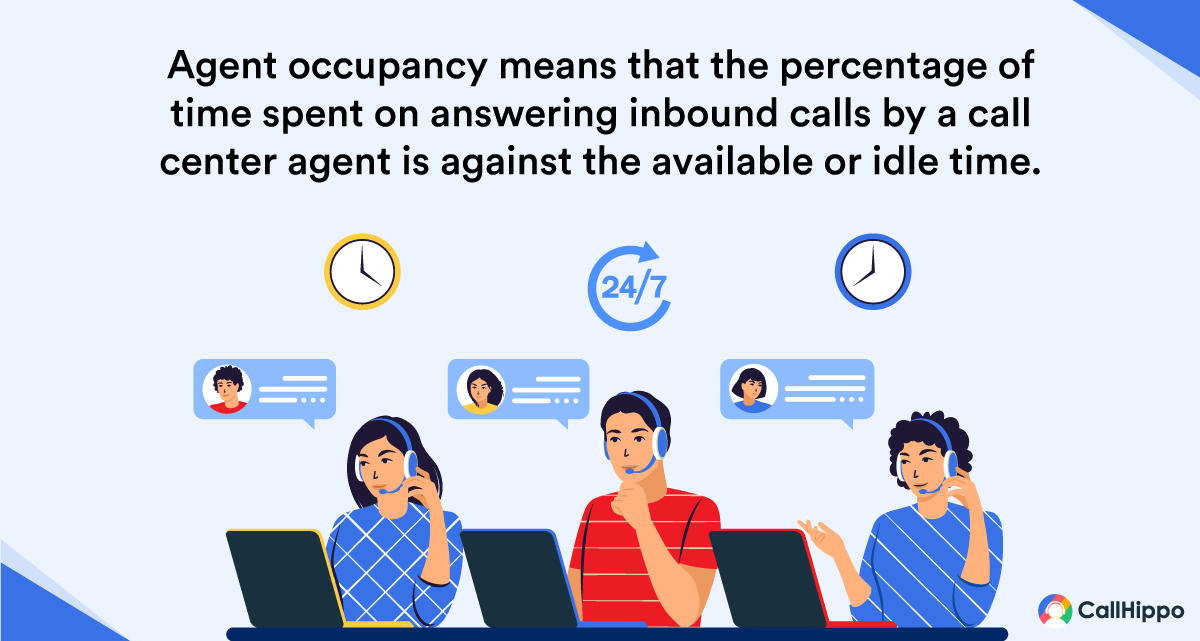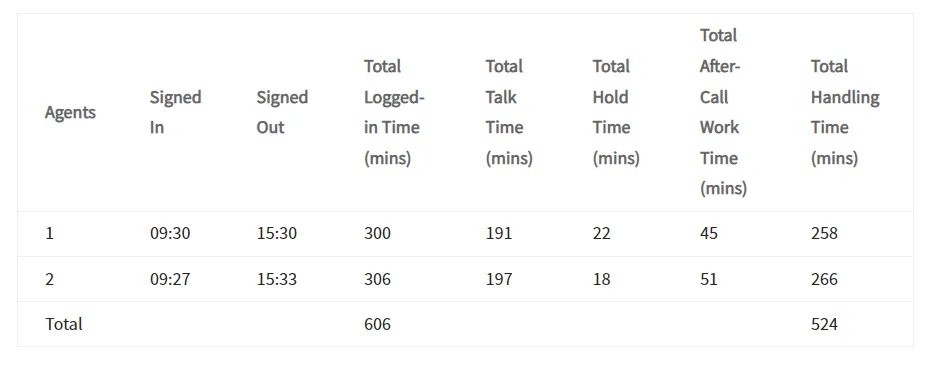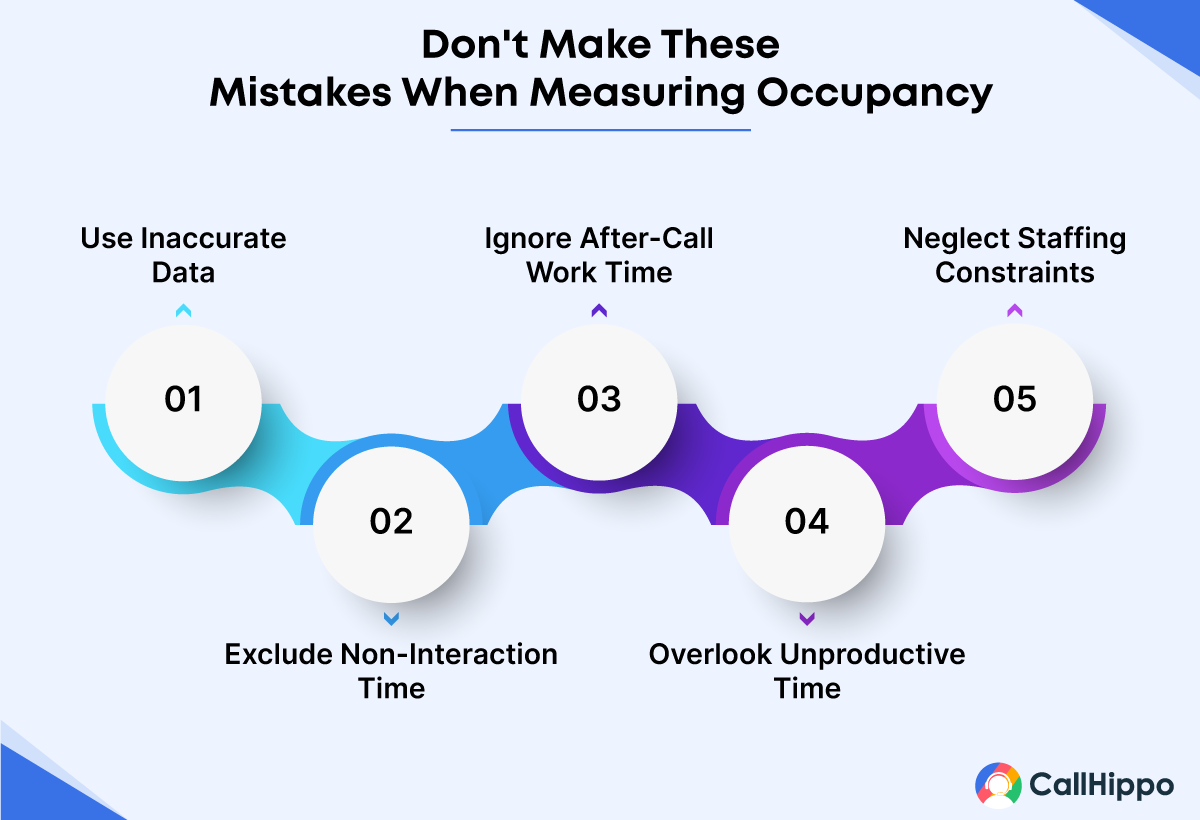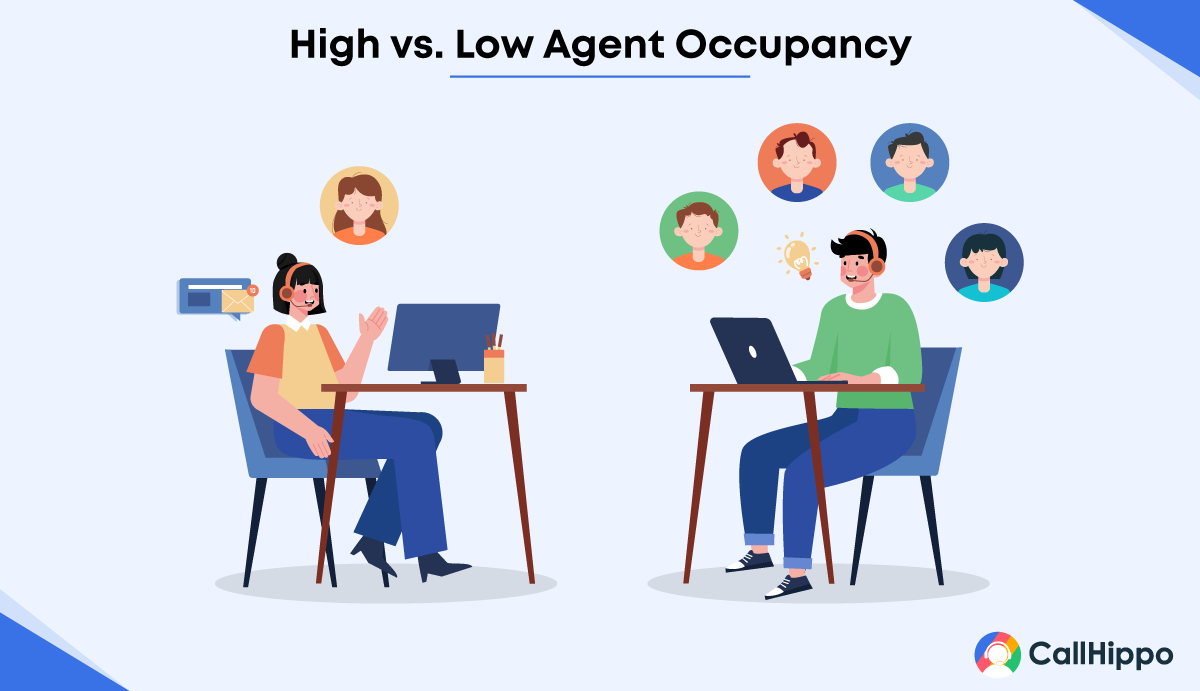Optimizing agent performance is essential in the fast-paced world of call centers, where customer service is paramount. To achieve this, call center managers rely on various metrics to assess and enhance their agents’ efficiency and productivity. Among these metrics, the occupancy rate is a crucial indicator of agent workload, staffing levels, and overall service effectiveness.
The occupancy rate provides valuable insights into how effectively agents are utilized, calculates how many agents you need, and the potential impact on customer satisfaction.
By accurately calculating and continuously monitoring occupancy, call center managers can make informed decisions regarding staffing levels, training programs, and operational adjustments to achieve optimal performance and business goals.
But what is occupancy in a call center? What is a good occupancy rate for a call center? And how do you calculate and improve it? Let’s understand all these in detail.
What Is Occupancy in a Call Center?
Occupancy in call centers refers to the time call center agents spend actively handling customer interactions or being occupied with work tasks, compared to their total available working time. It is expressed as a percentage and provides insights into agent utilization and workload management.

In simpler terms, occupancy is a metric that determines how busy agents are during their working hours. A high occupancy rate indicates that agents consistently handle calls or perform other work-related activities. In contrast, a low occupancy rate suggests that agents have periods of idle time or are not fully utilized.
Why Is Occupancy An Important Metric In Call Centers?
Occupancy rate directly impacts both agent performance and customer satisfaction. An excessively high occupancy rate can lead to agent burnout, decreased call center efficiency, and compromised service quality, as agents may feel overwhelmed and rushed. On the other hand, a low occupancy rate can result in underutilization of resources, increased costs, and longer wait times for customers.
Moreover, occupancy helps call center managers to optimize resources, particularly staffing levels. By monitoring occupancy rates, managers can identify periods of high or low demand and adjust the number of agents accordingly. If occupancy is consistently high, it may indicate a need for additional staff to handle the workload effectively.
How To Calculate Occupancy in a Call Center?
Here’s how you can calculate occupancy in a call center.
Call center occupancy rate formula:
Occupancy = (Time spent on call-related activity / Total logged-in time) X 100
Where,
Time spent on call-related activity = Total talk time + Total hold time + Total after-call work time
Total Logged-in time = The time spent in the system (between sign-in and sign-out)
Here’s an example to help you better understand how to calculate the occupancy rate for two agents:

Occupancy for Agent 1: (258/300) X 100 = 86.0%
Occupancy for Agent 2: (266/306) X 100 = 86.92%
Try to maintain your agents’ occupancy rate between 85-90%. A number less than that could reduce customer satisfaction, and a number more than that could lead to agent burnout.
You May Also Read: Best Call Center Software for Businesses
Mistakes To Avoid While Measuring Occupancy
While measuring occupancy in contact centers, it’s important to be aware of potential mistakes that can compromise the accuracy and effectiveness of the metric. Here are some common mistakes to avoid:

- Incomplete or Inaccurate Data Collection: Ensure that data collection methods are comprehensive and accurate. Relying on partial or inconsistent data can lead to incorrect occupancy calculations. Utilize reliable and robust systems for tracking agent activities, such as automated call logging and activity tracking tools, for capturing a complete picture of agent workload.
- Excluding Non-Interaction Time: It’s essential to include both customer interaction time and non-interaction time, such as breaks, administrative tasks, and training, when calculating the occupancy rate. Neglecting to account for these non-interaction activities can significantly skew occupancy rates and lead to incorrect assessments of agent productivity.
- Ignoring After-Call Work (ACW) Time: After completing a customer interaction, agents often require some time to wrap up tasks related to that call, such as updating records or documenting notes. Failing to consider After-Call Work (ACW) time can underestimate the actual time agents spend on each interaction, leading to inaccuracies in occupancy calculations.
- Overlooking Unproductive Time: Unproductive time, such as technical issues, system downtime, or waiting for available calls, should be accounted for in occupancy calculations. Neglecting to include unproductive time can overstate agent availability and result in inflated occupancy rates that do not reflect actual agent engagement.
- Inconsistent Periods: Ensure consistency in the periods used for occupancy calculations. Suppose the total available working time varies across different agents or shifts. In that case, it can lead to inconsistent occupancy comparisons and make evaluating performance or accurately identifying staffing needs challenging.
- Failing to Consider Staffing Constraints: Occupancy should not be the sole factor determining staffing decisions. It’s essential to consider other factors like service level goals, customer demand patterns, and agent skill sets. Relying solely on occupancy rates to determine staffing levels can result in suboptimal resource allocation and potential service quality issues.
- Neglecting Real-Time Monitoring: Occupancy should be continuously monitored in real-time to respond promptly to fluctuations in call volume or agent availability. Relying solely on periodic or retrospective analysis may lead to delayed interventions and missed opportunities for optimizing workforce management.
- Overemphasizing Occupancy as a Standalone Metric: While occupancy is an important metric, it should be considered alongside other relevant metrics, such as service level, customer satisfaction, and agent performance. Overemphasizing occupancy without considering the broader context can result in suboptimal decision-making and missed opportunities for improving overall call center performance.
"Regularly assess and analyze occupancy data, identify trends, and implement strategies to optimize agent productivity and customer service levels. Experiment with scheduling, training, and workload distribution to find the most efficient and balanced approach. Embrace a culture of learning and adaptability to drive ongoing improvement in call center operations."
Occupancy vs. Utilization: The Difference
Occupancy and utilization are two related but distinct metrics used in call centers to measure agent productivity and resource allocation. While they are often used interchangeably, understanding their differences is essential.
Occupancy, as mentioned earlier, measures the proportion of time agents spend actively handling customer interactions or work-related tasks compared to their total available working time. It focuses on the agent’s engagement and workload during their working hours. Occupancy is typically expressed as a percentage and helps assess agent efficiency, service levels, and staffing requirements.
On the other hand, utilization measures the proportion of time agents spend on productive work tasks compared to their total available time, including customer interactions and other call-related activities such as administrative tasks, training, or breaks.
Utilization encompasses all activities contributing to agent productivity, not just customer interactions. It is also expressed as a percentage and provides insights into how effectively agents utilize their available time, including on-call and off-call activities.
Effects of Occupancy [High and Low]
A call center’s occupancy rate, whether high or low, can significantly impact its potential to utilize its resources properly and provide exceptional customer service. Let’s understand how.

High Occupancy Effects
- Agent Stress and Burnout: Excessively high occupancy rates can significantly stress call center agents. Agents may feel overwhelmed by constant customer interactions and a high workload, leading to increased stress levels and potential burnout. This can negatively impact their performance, motivation, job satisfaction, and well-being.
- Reduced Service Quality: High occupancy rates can lead to decreased service quality. Agents may have limited time to thoroughly address each customer’s needs, resulting in rushed interactions, decreased attention to detail, and potential errors. This can lead to customer dissatisfaction, lower customer loyalty, and negative impacts on the overall customer experience.
- Increased Customer Wait Times: With high occupancy rates, agents may not be readily available to handle incoming calls, resulting in longer customer wait times. Prolonged wait times can frustrate customers, reduce their satisfaction levels, and potentially lead to customer churn or negative word-of-mouth.
- Decreased First Call Resolution (FCR) Rates: High occupancy rates can negatively affect First Call Resolution (FCR) rates. When agents are rushed and unable to dedicate adequate time to each customer interaction, the likelihood of resolving issues on the first call may decrease. This can increase call escalations, longer handling times, and decrease overall efficiency.
Low Occupancy Effects
- Underutilized Resources: Low occupancy rates indicate that call center agents have periods of idle time or are underutilized. This implies inefficiency in resource allocation and can result in wasted labor costs. The call center may need to review staffing levels, redistribute work tasks, or implement strategies to increase agent utilization.
- Increased Costs: With low occupancy rates, call centers may have more agents available than necessary to handle customer demand. This can lead to increased labor costs without corresponding benefits in productivity. Call center managers may need to reevaluate staffing plans and find ways to optimize resource allocation to reduce costs.
- Inefficient Workforce Management: Low occupancy rates may indicate inefficiencies in workforce management. It suggests that call center managers are not effectively aligning staffing levels with customer demand. It is crucial to accurately forecast call volume and schedule agents accordingly to maintain a balanced workload and maximize productivity.
- Decreased Agent Engagement: When agents have extended periods of idle time due to low occupancy, they may experience decreased engagement and motivation. The lack of challenging and meaningful work can lead to decreased job satisfaction and disengagement among agents. This, in turn, can impact their performance, quality of service, and overall customer experience.
How To Improve Call Center Occupancy?
There are several ways to improve the call center occupancy rate, including monitoring call volumes at different times, holding cross-training sessions, reducing the number of agents, and partial outsourcing. Let’s understand it in detail.
1- Monitor Call Volume At Different Times
The amount of incoming calls varies throughout the day. There will be both peak and quiet hours. By monitoring call volume across hours and days, you will be better able to determine the appropriate staffing level for busy and quiet periods.
2- Hold Cross-Training Programs
Blended agents boost call center occupancy rates by handling inbound and outbound calls. But, to make handling inbound and outbound calls effective, you must hold training programs for the agents. It would teach them the best practices for both types of calls and prepare them to handle more calls during quiet hours.
3- Reduce the Number of Agents
Overstaffing is one of the biggest reasons for a low occupancy rate. Analyze the number of calls received in the last three months to determine an approximate number of the calls you will likely receive in the coming months. You can then reduce the number of agents accordingly to maintain higher occupancy rates throughout the call center.
4- Consider Partial Outsourcing or Hiring Remote Agents
It might not be easy to attend all the calls during peak hours. If you rush agents to complete the calls quickly and hop onto another, it might hurt the customer satisfaction rate. Thus, consider outsourcing or hiring remote agents to handle additional calls during peak hours. It ensures the occupancy rate is maximum for each employee without compromising the service quality.
Conclusion
Optimizing occupancy in call centers is essential for maximizing agent productivity, delivering exceptional customer service, and achieving operational efficiency. By striking the right balance and avoiding measurement pitfalls, call center managers can create a productive work environment, enhance service quality, and drive business success. However, ensure that you don’t solely use occupancy in call center metrics for measuring agents’ performance.
FAQ
What is a good occupancy rate for a call center?
A good occupancy in the call center is 85-90%. Anything less than that could negatively impact customer satisfaction, and a number more than that could lead to agent burnout and might increase agent attrition.

Subscribe to our newsletter & never miss our latest news and promotions.










